Check out the full big wall video course, or download the e-book.
Portaledge Setups
You should position your portaledge in such a way that it is easy to access things from inside your haulbags. The main challenge is usually making the belay wide enough so the portaledge can hang next to the haulbags.
Some belays have 3 or 4 widely spaced bolts, which makes the task easy, whereas others only have 2 bolts close together. Some can be spread wide apart by adding gear at the sides and others cannot.
Visualize where your portaledge and haulbags will be while you are making the anchor, so you don’t have to re-make the anchor later.
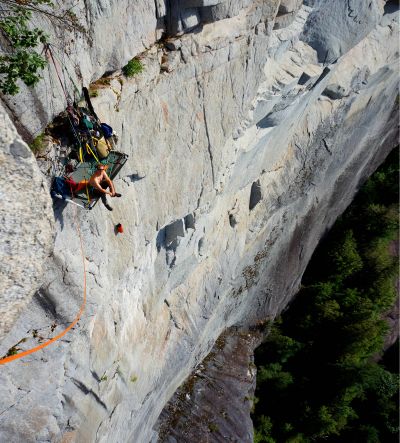
Example Portaledge Setups
- Haulbag docked on left bolt, backed up to main point
- Portaledge hanging from right bolt, backed up to center bolt
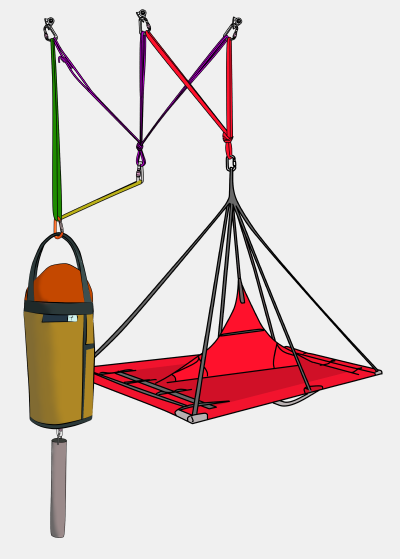
- Haulbags docked on left bolt, backed up to main point
- Portaledge hanging from trad gear, backed up to right bolt
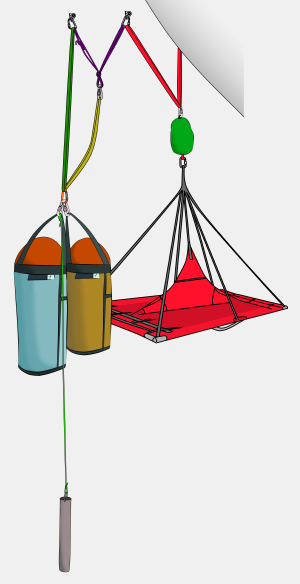
- Haulbags docked and backed up on main point
- Both portaledges hanging from trad gear, backed up to a bolt
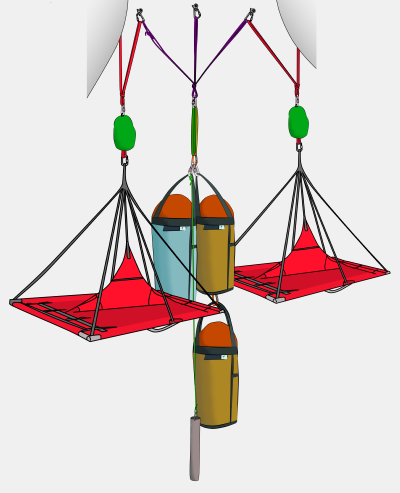
- Haulbags docked on left bolt, backed up to main point
- Portaledge hanging from right bolt, backed up to main point
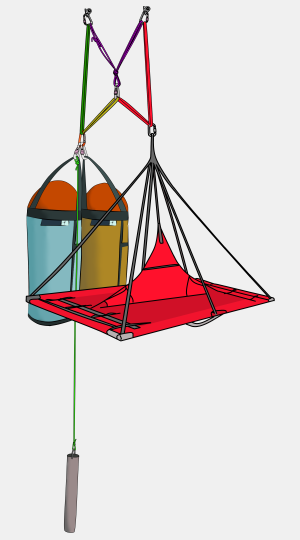
If you have a narrow 2-bolt anchor with no gear to spread things out, you can set up the bivi as shown here.
This keeps everything within reach and works well if you don’t need to access the haulbag’s bottom layer.
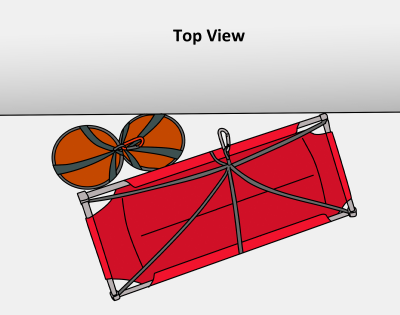
Tying In on a Big Wall
You should keep your harness on and remain tied in with the rope throughout the night. Tie into the main point, making your rope long enough so you can move around the bivi and get in your sleeping bag. An excessively long tie-in is obviously dangerous.
Never untie any knot from the anchor unless you are certain what it is – the random knot you unfasten might be your partner’s tie-in!
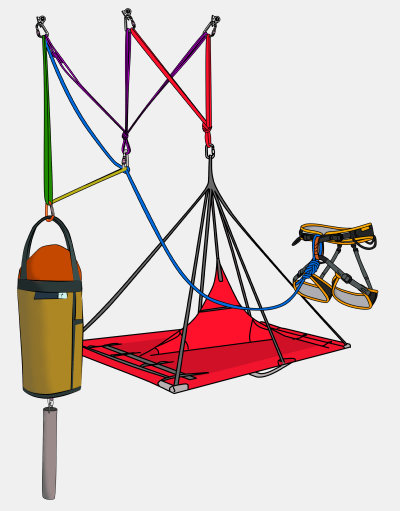
Tying in when the Portaledge Fly is on
Have your tie-in rope entering through the top of a door. The rope is weighted down with a few bunches of carabiners or pitons as shown. Rain water will soak down your rope, but not up it.
If you have a taught tie-in rope, rain will soak all the way down it into your sleeping bag.
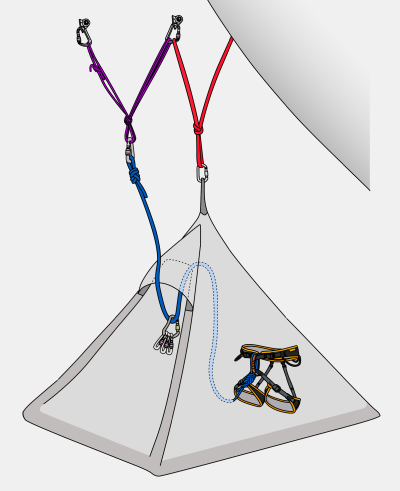
Some portaledge manufacturers recommend that you tie in as shown to offer the best protection during a storm. However, this means that you, your partner, the portaledge and everything inside it is hanging on a single carabiner and sling which are out of sight on the outside of the fly.
Also, unless you bring a full rope inside the ledge with you (which may not be available if you’ve fixed pitches above), you won’t have a dynamic tie-in.
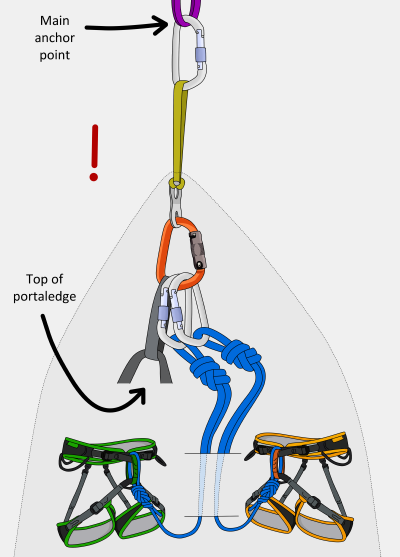
Pre-Attaching the Portaledge Fly
Unless you are certain of good weather, it’s highly advisable to set your portaledge up with the fly pre-attached above. Keep the fly stuffed away inside its bag, and attached as shown.
If it gets cold, windy or stormy in the night, you can quickly deploy the fly. Remember that your portaledge will hang approx 60cm lower when the fly is attached.
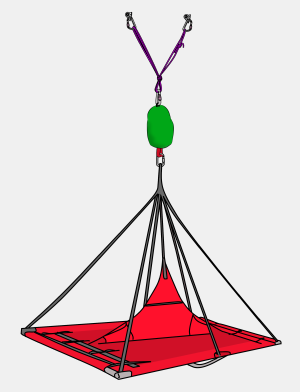
Stabilizing the Portaledge
Aim to get the wall-side corners of your portaledge to touch the wall.
A corner which doesn’t contact the rock is less stable.
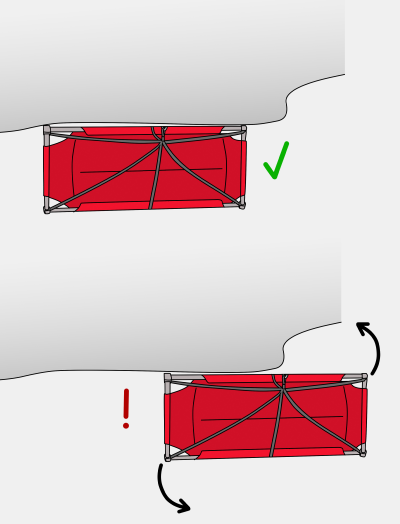
Portaledges can be fairly unstable when weighted only on one side. This tends to be a problem at the most inconvenient times – when you are leaning over to get things out of the haulbag, or standing on the side of the ledge to have a pee.
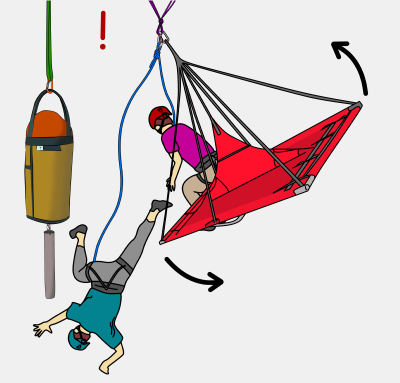
To stabilize your setup, attach a sling from the wall-side corner of the portaledge to the anchor as shown. This allows you to stand on the very corner of your portaledge without fear of it suddenly inverting.
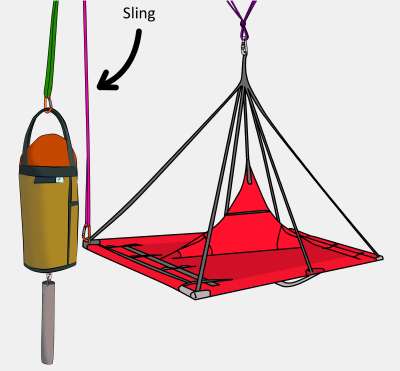
Portaledges will hang differently on slabs than on steep ground.
Adjust the straps as necessary to create a flat living space.
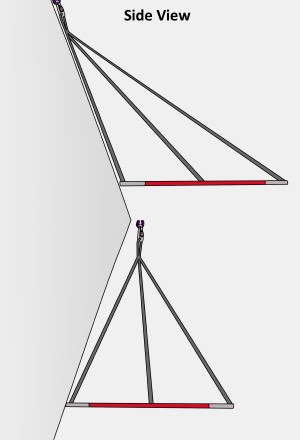
Where To Clip Stuff on a Big Wall Bivi
When it’s time to delve into the haulbags, get 10-15 spare carabiners (bivi biners) ready for clipping things. Avoid clipping random stuff to the main point of the anchor or portaledge. Keep these areas clear for important things like your tie-in knots. A good solution is to clip an aider to a belay bolt and use its steps to clip various things (e.g: shoes, helmets, stuff from your harness) that you probably won’t need overnight.
Stuff that you’ll need during the evening (e.g: stove, food, music) can be clipped on to portaledge straps so you don’t need to move from your seated position until its time to sleep. At which point, all this stuff can either be put in the top of a haulbag or clipped high on the portaledge so it doesn’t dangle around your face all night. Keep breakfast stuff within reach, so in the morning you can wake up and eat without getting out of your sleeping bag.
Natural Big Wall Bivi Ledges
Natural bivi ledges are an island of luxury on a big wall. Many climbers plan their ascent so they can spend the night on natural ledges.
It’s also much easier to reorganise haulbags (e.g: move empty water bottles to the bottom and retrieve spare food) when they’re sitting on a rock ledge.
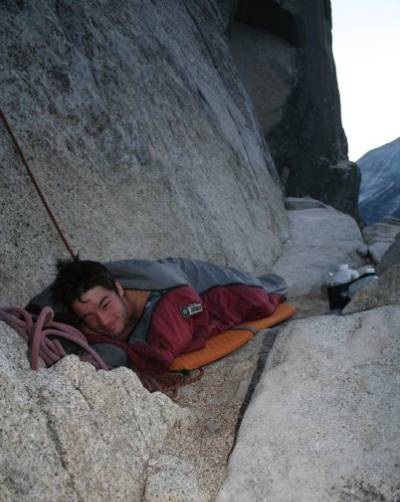
Cooking on a Big Wall
Having a warm meal or coffee is an excellent luxury on the wall. If you choose to take a stove, make sure you understand the drawbacks of using them because they can be quite serious. Without care you could burn a hole through a portaledge, rope or sling, scald yourself on boiling water or get carbon monoxide poisoning. To avoid this:
Vent
Open the door of your portaledge fly to ventilate the cooking area. Carbon monoxide builds up quickly in a closed portaledge and can kill.
Be Ready
Get everything ready and within reach before firing up the stove so there is no movement when it’s running.
Hang
Hang the stove somewhere so that it can’t possibly burn through anything. Give it a lot of space. Remember that heat travels through carabiners.
Stove Operator
Have one person as the stove operator and one as doing everything else (opening packets etc..).
Protect
Pull a sleeping bag over yourself when cooking – a wet sleeping bag is better than a first degree burn.

How To Poo on a Big Wall
It’s good to have a routine where all climbers have one poo at the same time each day. The simul-poo will ideally take place in the morning or evening when the portaledge is set up and the poop tube is handy. Keep your harness on during the whole event. Unclipping the rear risers enables you to pull your pants down more easily. Tuck them away so they don’t swing around in the poo bag.
Keep the portaledge stable so you don’t end up with poo stuck to your sleeping bag, pants, ropes, rack, hands, unhappy partner, in the gates of carabiners or missing the bag entirely (all of these things have happened to me...).
A sleeping bag hanging down the middle of your portaledge acts as an excellent barrier so you don’t have to watch your partner wiping her arse while you’re eating a chocolate spread bagel. Some climbers prefer to take Imodium tablets every day to eliminate this whole ordeal, and instead just deposit one monster load on the summit. There are obvious drawbacks with this strategy and it’s perhaps healthier to just have your daily dump as normal.
Dealing with urine is easier for men than women. Simply aim out from the wall, keeping urine away from cracks, ledges and climbers below. Shewee’s make this task easier for women, but they apparently take some practise to use successfully. On popular routes, it’s worth having a pee bottle (wide-mouthed Nalgene bottles work for women). Pour it out when appropriate. Make sure to label any water bottle that has been used for this purpose. Pee bottles are useful at night and also to separate liquids from solids during your morning routine.
Big Wall Weather
It’s recommended to check the weather forecast before your ascent and bring a device with you so that you can check the weather again on the wall. Some big wall destinations have long periods of stable weather (e.g: Yosemite), while others have unpredictable and notoriously bad weather (e.g: Patagonia). Keep your storm gear accessible if poor weather is predicted.
Sun
Often the main weather-related challenge in warm climates is the intense sun. On a sun-facing wall (e.g: El Capitan), the sun is hot, bright and inescapable for most of the day. Cover up your skin, use plenty of sunscreen and make sure to drink enough water. On long belays you could make some kind of shady shelter behind a jacket or portaledge fly.
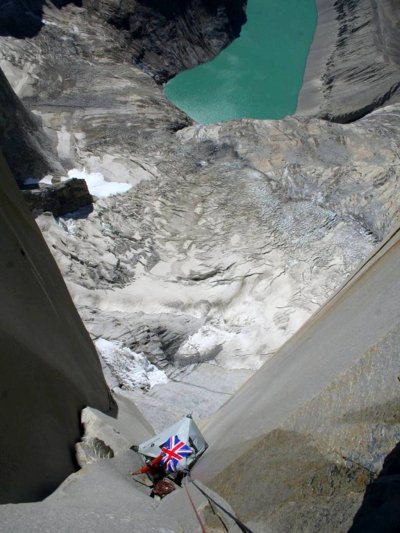
Wind
Strong winds are common on warm afternoons, especially higher up on south-facing Yosemite walls. This is due to convection currents created in the valley. As the sun heats up the ground, warm air rises and can generate quite strong updraughts. These are excellent at removing ropes from rope bags, causing chaos with portaledges and making pee go in an unexpected direction. In serious wind-storms (common in Patagonia), you’ll need to anchor your equipment down from underneath to avoid upturned haulbags and ‘surfing’ your portaledge around the wall.
Storms
Thunderstorms can instantly turn friendly granite into a freezing cold torrential waterfall, even in Yosemite. The difference in temperature is dramatic and can be very serious if you’re not prepared. If you choose to climb during a storm, water will find its way up your sleeves, under your hood, inside your shoes and everywhere in between. If you choose to abseil, rain will collect at your belay device and pour into your crotch and down your legs. Not even the best waterproofs will stop you from getting soaked.
The danger increases exponentially with every minute that you are exposed to the elements. As you get colder you lose mobility in your hands. Carabiners will be harder to operate and you will be more likely to drop gear. Being too cold leads onto making poor decisions and is a slippery slope into a much worse situation. Avoid a disaster from the start by bringing the right gear and setting up shelter before the storm hits.
If a storm is rolling in, first focus on getting to the closest place which will be sheltered from a waterfall, if you have time. Black mossy streaks on the wall are a good indicator of where waterfalls form during storms. Belays beneath roofs are great shelters. Bivying in a storm is undesirable, but bivying underneath a waterfall is a whole new level of misery. Small rocks and general wall-debris also tend to get washed down within the waterfall.
If you have proper bivi gear (which you should), it is much better to wait out a storm, than to continue up (or down) during it. Proper bivi gear includes a synthetic sleeping bag, synthetic layers, water-proof jacket, gloves, water-proof bivi bag and a portaledge rain-fly. With the right gear, waiting out a storm can actually be pretty fun, especially if you have a radio and some beers. For extra warmth, fill a Nalgene bottle with hot water and keep it between your thighs in your sleeping bag. If you are running low on water, take advantage of the situation and fill up your bottles with rain.





